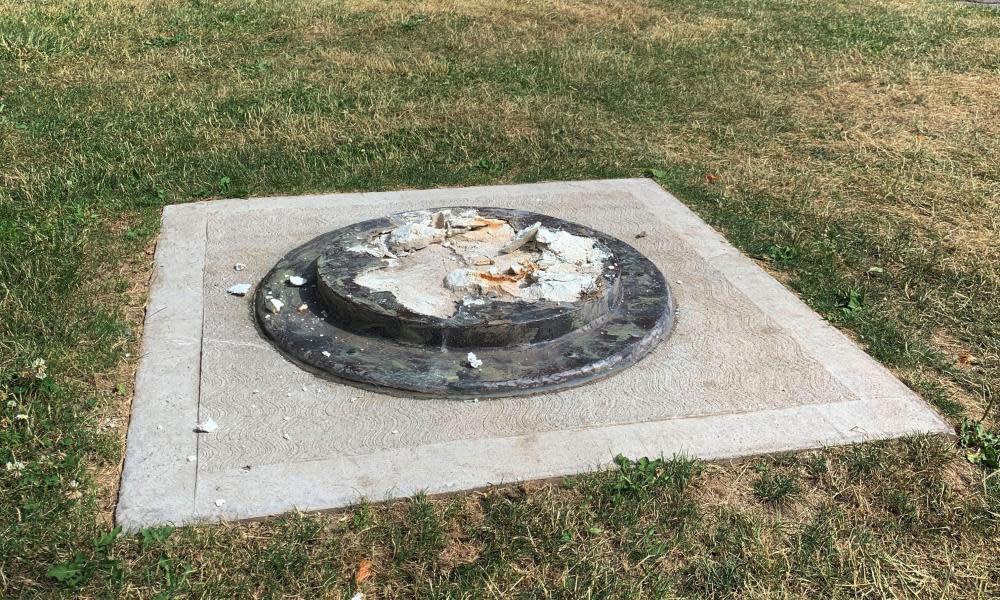Frederick Douglass statue torn down on anniversary of great speech

A statue of the great abolitionist Frederick Douglass was torn from its base in Rochester, New York on Sunday, 168 years to the day since the city was the setting for one of his greatest speeches, What to the Slave is the Fourth of July?
Related: Discovery of Frederick Douglass letter sheds light on contested Lincoln statue
The statue stood in Maplewood Park, a site on the Underground Railroad, the network through which Douglass and Harriet Tubman, both escaped slaves themselves, and others helped ferry people enslaved in southern states to freedom in the north.
One of 13 statues which were placed around Rochester in 2018, the 200th anniversary of Douglass’s birth, the monument was found next to a river gorge, about 50ft from its pedestal, police said. The base and a finger were damaged.
Carvin Eison, who worked on the project which brought the statues to the city, told the Democrat & Chronicle newspaper: “It’s particularly painful that it happened at this time … It’s really sad because here in Rochester the statue of Frederick Douglass has always been a face of good.”
The statue would be replaced, he said.
Since the killing of George Floyd, an African American man, in Minneapolis on 25 May prompted nationwide protests against police brutality and structural racism, statues of Confederate leaders and others with outdated views on race have been targeted for protest, vandalism and removal.
Donald Trump has placed himself at the head of a counter-movement, defending Confederate heritage and, over the Fourth of July weekend, calling for the creation of his own sculpture park, or “National Garden of American Heroes”, in defiance of supposed “far-left fascism”.
Though the perpetrators of the Rochester removal remain unknown, in a Monday morning tweet, Trump said it showed “these anarchists have no bounds!” and linked to a piece by the far-right Breitbart News.
Speaking to WROC, Eison asked: “Is this some type of retaliation because of the national fever over Confederate monuments right now? Very disappointing, it’s beyond disappointing.”
In 2018, two students were arrested for vandalising another Douglass statue in the city.
Douglass’s own views on such monuments have come into focus in Washington DC, where a statue of Abraham Lincoln and a formerly enslaved man has been the subject of calls for removal.
In an 1876 letter recently discovered by a historian, Douglass writes: “The negro here, though rising, is still on his knees and nude. What I want to see before I die is a monument representing the negro, not couchant on his knees like a four-footed animal, but erect on his feet like a man.”
He also says the Lincoln statue is “admirable” and adds: “The mere act of breaking the negro’s chains was the act of Abraham Lincoln and is beautifully expressed in this monument.”
Douglass escaped from slavery in Maryland in 1838 and eventually made Rochester his home, though he also lived in Washington. He died in 1895 and is buried in Mount Hope cemetery, in Rochester.
He gave his speech on the Fourth of July and slavery on 5 July 1852, two years after the passage of the Fugitive Slave Act and as the nation slid towards disunion and, in 1861, civil war.
Douglass was a fierce campaigner who in 1855, in another Rochester speech, famously said: “I would unite with anybody to do right, and with nobody to do wrong.”
But his 1852 speech is a powerful rebuke to America’s white majority, then celebrating the 76th anniversary of independence from Britain.
Douglass commends the revolutionary spirit, saying “the eye of the reformer is met with angry flashes, portending disastrous times”.
He adds: “To side with the right, against the wrong, with the weak against the strong, and with the oppressed against the oppressor! Here lies the merit, and the one which, of all others, seems unfashionable in our day.”
Related: David Blight on Frederick Douglass: 'I call him beautifully human'
But he goes on to tell his white audience: “The blessings in which you, this day, rejoice, are not enjoyed in common. The rich inheritance of justice, liberty, prosperity and independence, bequeathed by your fathers, is shared by you, not by me. The sunlight that brought life and healing to you, has brought stripes and death to me.
“This Fourth July is yours, not mine. You may rejoice, I must mourn. To drag a man in fetters into the grand illuminated temple of liberty, and call upon him to join you in joyous anthems, were inhuman mockery and sacrilegious irony.”
To a slave, Douglass says, America’s annual celebration of independence is “a day that reveals to him, more than all other days in the year, the gross injustice and cruelty to which he is the constant victim.”

 Yahoo News
Yahoo News 
